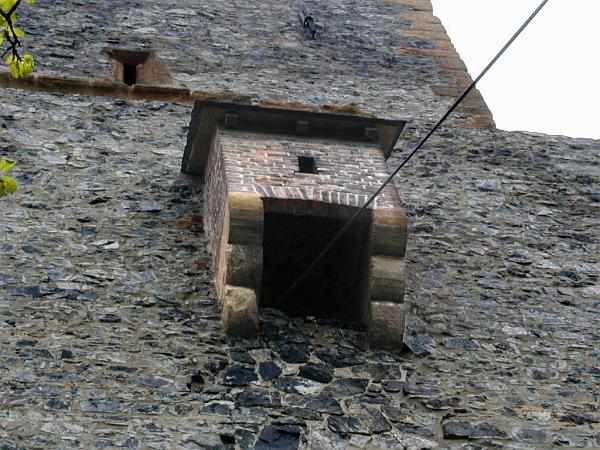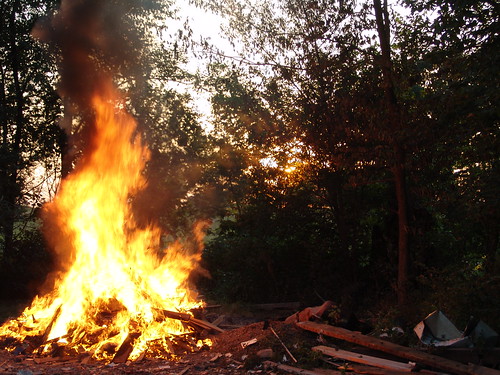Recycling is not a modern invention. I remember growing up and being thoroughly fascinated watching my grandmother carefully saving tinfoil, wrapping paper and other things that I would have gleefully tossed in the trash. She was a product of wartime and The Great Depression, but she was demonstrating skills that are common in any time of want. How used goods were processed typically depended on the wealth of the household. Great houses may let the staff eat the leftovers, donate them to the poor, or feed them to the pigs. Bones were cracked for the marrow or thrown to the dogs. My grandmother was a great one for making "salads" of whatever small portions remained, for her next night's dinner. Old clothing could be donated to the needy (as the rich sometimes did to the theater) or sold to the fripper. Torn clothing would be mended or patched. Clothing too far gone for mending would be used for patches, or as rags. I've used the term recycling here in the "continued use" sense, but scrap metals (nails, barrel hoops, etc) were certainly collected and melted down for reuse as well.
 Sewers have been utilized by civilizations off and on since at least 2500BC in Eshnunna. Some had water flushed latrines (even London had a few tidally flushed by the Themes). Others had associated septic tanks for the collection of material outside of the city. Brick, stone and even clay pipes have been used to construct these ancient disposal systems. However, in many cities of Europe a "sewer" simply meant a lined ditch intended for storm water, which flowed into the nearest stream or river. Some communities connected these storm water drains to simple cesspools, which would then drain back into the water supply. The sludge would be contained (producing a lovely odor, naturally) and mucked out at need. The vaunted sewers of Paris (begun in 1370) at the outset only redirected waste water from the Seine to the "Ménilmontant" brook. Even in more recent history, natural waterways have been enclosed (my parents remember some old streams in Philadelphia that used to run interesting colors due to a nearby chemical plant) to serve as sewers and protect residents from direct contact with the waste.
Sewers have been utilized by civilizations off and on since at least 2500BC in Eshnunna. Some had water flushed latrines (even London had a few tidally flushed by the Themes). Others had associated septic tanks for the collection of material outside of the city. Brick, stone and even clay pipes have been used to construct these ancient disposal systems. However, in many cities of Europe a "sewer" simply meant a lined ditch intended for storm water, which flowed into the nearest stream or river. Some communities connected these storm water drains to simple cesspools, which would then drain back into the water supply. The sludge would be contained (producing a lovely odor, naturally) and mucked out at need. The vaunted sewers of Paris (begun in 1370) at the outset only redirected waste water from the Seine to the "Ménilmontant" brook. Even in more recent history, natural waterways have been enclosed (my parents remember some old streams in Philadelphia that used to run interesting colors due to a nearby chemical plant) to serve as sewers and protect residents from direct contact with the waste.  Shitting is one of those basic facts of life that is easily skipped over in most writing (though it can be used to great effect, see: Martin, George R R). It is however a necessity for all people and the remains must be dealt with for the sake of health and atmosphere. In a large percentage of situations, this involves the use of a privy. The privy (necessary, shitter, what have you) is generally a collection place, but in castles they were at times built on exterior walls, projecting over the moat. In cities, privies were often located in the cellar and might be as simple as a wooden board placed over an open hole. There are stories of these boards breaking and the unfortunate resting
upon them departing this life in a most distasteful manner. Alternatively, chamber pots might be used and emptied into the basement cesspit. Though it was usually outlawed, it was not uncommon for the contents of the chamberpot to be simply flung out the window (people were lazy at times back then too). Once these cesspits reached capacity, it was time to call the gong farmer. Yep, guys came to your place to shovel out your shit. This was usually regulated so it would only be done at night (since the cart rolling down the street afterwards can't have been pleasant). It was not terribly uncommon for these basement privies to become overfilled. Privies in rural areas, might be located in separate buildings from the main house (aka outhouses). These could either be harvested for fertilizer, or simply covered over and a new one dug at need.
Shitting is one of those basic facts of life that is easily skipped over in most writing (though it can be used to great effect, see: Martin, George R R). It is however a necessity for all people and the remains must be dealt with for the sake of health and atmosphere. In a large percentage of situations, this involves the use of a privy. The privy (necessary, shitter, what have you) is generally a collection place, but in castles they were at times built on exterior walls, projecting over the moat. In cities, privies were often located in the cellar and might be as simple as a wooden board placed over an open hole. There are stories of these boards breaking and the unfortunate resting
upon them departing this life in a most distasteful manner. Alternatively, chamber pots might be used and emptied into the basement cesspit. Though it was usually outlawed, it was not uncommon for the contents of the chamberpot to be simply flung out the window (people were lazy at times back then too). Once these cesspits reached capacity, it was time to call the gong farmer. Yep, guys came to your place to shovel out your shit. This was usually regulated so it would only be done at night (since the cart rolling down the street afterwards can't have been pleasant). It was not terribly uncommon for these basement privies to become overfilled. Privies in rural areas, might be located in separate buildings from the main house (aka outhouses). These could either be harvested for fertilizer, or simply covered over and a new one dug at need.  One of the simplest ways to dispose of trash is to burn it. Drive through rural communities today and you can still spot the odd trash fire. This serves multiple purposes. Heat is the obvious byproduct, which is great especially in winter months and in those places where it might not be easy or cheap to heat your home. Additionally, it is important to dispose of excess combustible material to protect against fires. When my parents were growing up in Philadelphia, they use to rake all of the leaves out in the street and burn them. Controlled burns are also used in forestry to limit the impact of wildfires. Burning trash is regulated in the US today primarily due to the presence of noxious chemicals that would be released into the air as a result of the combustion.
One of the simplest ways to dispose of trash is to burn it. Drive through rural communities today and you can still spot the odd trash fire. This serves multiple purposes. Heat is the obvious byproduct, which is great especially in winter months and in those places where it might not be easy or cheap to heat your home. Additionally, it is important to dispose of excess combustible material to protect against fires. When my parents were growing up in Philadelphia, they use to rake all of the leaves out in the street and burn them. Controlled burns are also used in forestry to limit the impact of wildfires. Burning trash is regulated in the US today primarily due to the presence of noxious chemicals that would be released into the air as a result of the combustion. Putting all of your refuse in one place instead of leaving it scattered about is a basic concept. Landfills are often the preferred method of disposing of this trash. Creating a landfill may simple an esthetic choice, since a large mound of trash is unsightly, but "fill material" has been used throughout history. The old city of Prague was raised a few feet in elevation with after centuries of flooding. Marshes were unusable areas which gave rise to the spread of disease (or at least mosquitoes). Once they were drained or filled they could start to earn money for their owners (my old high school was build on a marsh filled partly with industrial waste, yay). Low areas filled with trash, especially wood or poorly compacted materials, may later become sinkholes. I remember visiting a park in Lancaster (while in college) that had 10' diameter rolls of linoleum flooring peeking out from under a hill. Working later, I encountered an entire hill (maybe 30' high) composed entirely of spent shotgun casings, minus brass, covered with a thin layer of dirt (they manufactured and tested on site). Historically, old mines have also been used as convenient landfills.
Humanity has used quite a variety of methods to dispose of unwanted materials over the course of our history. Obviously, these methods would be used in combination and vary widely, depending on local environmental conditions and requirements. Methods well known in certain parts of the world were uncommon or a complete mystery in others. Disposal of things that are "unclean" also have important religious connotations and societal distinctions (which are beyond the scope of this post). I hope that this post makes you think for a second and gives imagination fuel for making your writing more atmospheric. We're still trying to harvest that methane effectively (sorry, landfill joke). Much thanks for this post goes to Timothy Truman's "Hawkworld" (1989), which first made me ask, "Didn't you ever wonder where it all goes when you flush the toilet?"
http://greywateraction.org/content/history-sewers
http://en.wikipedia.org/wiki/Paris_sewers
http://www.ancientfortresses.org/privy.htm
http://fascinatinghistory.blogspot.com/2005/05/cess-pits-and-chamber-pots.html
http://en.wikipedia.org/wiki/Incineration
http://www.timesunion.com/local/article/Burn-barrels-put-on-scrap-heap-of-history-552863.php
http://www.mcgeesghosttours.com/blog/?p=197
No comments:
Post a Comment